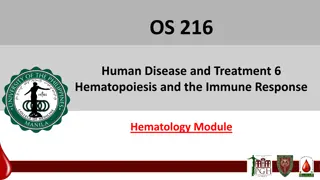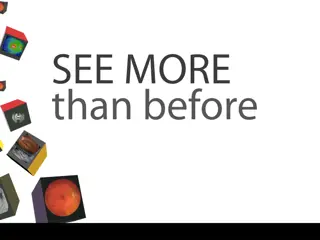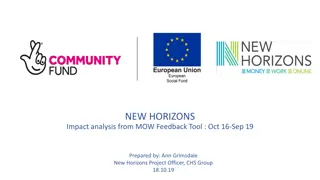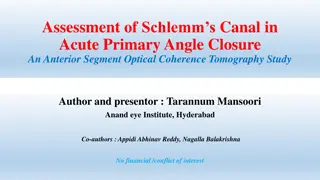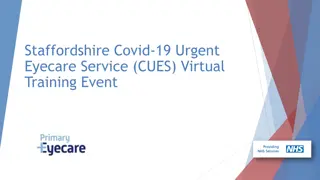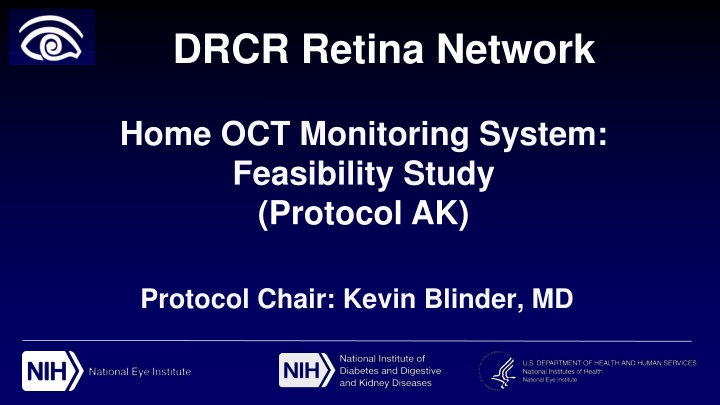
Home OCT Monitoring for Neovascular AMD: Feasibility Study
Discover the feasibility of utilizing a home optical coherence tomography (OCT) system for monitoring neovascular age-related macular degeneration (nAMD) patients. The Notal Vision Home OCT system offers convenient daily monitoring of intraretinal and subretinal fluid dynamics, potentially allowing for personalized treatment and improved outcomes.
Download Presentation

Please find below an Image/Link to download the presentation.
The content on the website is provided AS IS for your information and personal use only. It may not be sold, licensed, or shared on other websites without obtaining consent from the author. If you encounter any issues during the download, it is possible that the publisher has removed the file from their server.
You are allowed to download the files provided on this website for personal or commercial use, subject to the condition that they are used lawfully. All files are the property of their respective owners.
The content on the website is provided AS IS for your information and personal use only. It may not be sold, licensed, or shared on other websites without obtaining consent from the author.
E N D
Presentation Transcript
DRCR Retina Network Home OCT Monitoring System: Feasibility Study (Protocol AK) Protocol Chair: Kevin Blinder, MD
Background Treatment of neovascular AMD (nAMD) with anti-VEGF therapy is a major improvement but at a very high treatment burden and cost for patients and the healthcare system The ability to perform daily monitoring of intraretinal fluid and subretinal fluid using a home optical coherence tomography (OCT) system offers the opportunity to obtain a detailed assessment of fluid over time Understanding fluid dynamics for an individual patient may allow customization of treatment that may reduce treatment burden and improve long-term outcomes 2
Notal Vision Home OCT Notal Vision has developed an OCT system for at-home use, called Home OCT system The Notal Home OCT is an investigational device not cleared for clinical use Patient self-images daily Process takes less than one minute per eye Dense 88 B-scans spaced 30 m in 3x3 mm field of view visualizes small amounts of fluid Automatic data transmission to cloud 3
Notal Vision Home OCT Home OCT Device Monitoring center performs AI based quantification and tracking of intra- and subretinal fluid volume Retina specialist Home OCT Image sets fluid volume thresholds and is notified by monitoring center when criteria are met has 24/7 access to all images and data bills for data review every 30 days 4
Prior Notal Vision Studies In-Clinic Study 196 AMD patients (mean age 77 years) with VA >20/400 90% were able to self-operate the Notal Home OCT system and capture analyzable images following a 2 min tutorial >60% reported the self-scan method was quick and easy to understand and complete, and that the headrest was comfortable and easy to use The accuracy of the Notal OCT Analyzer (NOA) vs. retina specialists was 91% 7%, sensitivity was 92% 6%, and specificity was 91% 6% for detecting fluid presence (142 cube scans) 5
Prior Notal Vision Studies At-Home Study 4 participants (mean age 73.8 years) with nAMD (one or both eyes) completed daily self-imaging at home for 1 month 87.9% of imaging attempts were successful, 97.6% were satisfactory quality The NOA and human determination of presence of fluid agreed in 94.7% of cases From a subset of 24 scans with fluid, for agreement between NOA and human fluid volume measurements, the correlation coefficient was 0.996 and mean absolute difference was 1.5 nl (vs. 0.995 and 1.2 nl, respectively, for interhuman agreement) 6
Critical Questions for Home OCT Can the use of Home OCT monitoring reduce visit and treatment burden and at least maintain or possibly improve VA outcomes? Need large RCT to determine its role in clinical practice No such trial currently planned will be FDA approved as a device with no efficacy trial required What amount of recurrent fluid should be used as a threshold to prompt a follow up visit with a retina specialist? Will AI be sufficient for screening for recurrent activity? Logistics and how would interface with DRCR Retina Network not well understood Need feasibility study 7
Protocol AK: Home OCT Feasibility Study Observational Study of 15 participants from 3 sites Inclusion Criteria: Best corrected E-ETDRS VA 20/20 to 20/320 Ability to take daily Home OCT scans Active choroidal neovascularization (CNV) due to AMD in at least one eye in which the investigator intends to treat with anti-VEGF AMD defined as presence of at least one large drusen in either eye Active CNV defined as presence of intraretinal or subretinal fluid Exclusion Criteria: History of CNV or treatment for CNV in the study eye Participants will take daily Home OCT scans for 6 months Follow-up visits will occur as normally seen with standard care Any OCT scans obtained on the study eye (none are mandated by the study) will be uploaded to the Coordinating Center for grading & comparison with Home OCT scan taken same day
What We Will Learn Methods and logistics of image/data interpretation and transfer from Notal Willingness of patients to participate in and complete a program requiring home OCT monitoring Ability of clinic and Notal staff to educate patient Better understand fluid dynamics associated with treatment Agreement between Reading Center assessment of fluid on in-office OCT versus NOA fluid determinations from Home OCT scans 9





